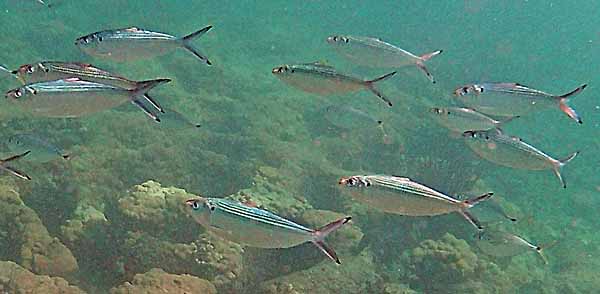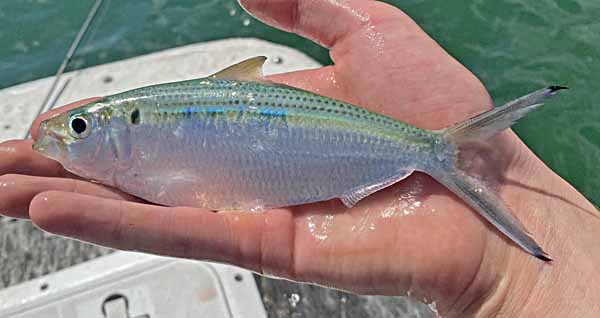Opisthonema oglinum
(Lesueur, 1818)
|
Familie: Dorosomatidae SynonymeMegalops oglina Lesueur, 1818
Megalops notata Lesueur, 1818 Lokale Bezeichnung |
Typen
Keine Typusexemplare bekannt.
Siehe: Eschmeyer, W.N., Fricke, R. & Van der Laan, R. (eds.) 2024. Catalog of Fishes electronic version
Typusfundort: Newport, Rhode Island, U.S.A.
Etymologie
Etymologie ungeklärt, es sei denn, es handelt sich um das Wort ogle, das sich auf seine großen Augen bezieht. (Übersetzt aus: The ETYFish Project)
Verbreitung
Westlicher Atlantik: Golf von Maine (U.S.A.) und Bermuda südlich bis Uruguay, einschließlich Golf von Mexiko und Karibisches Meer.
IUCN Status

EX Extinct (ausgestorben)
EW Extinct in the Wild (in der Natur ausgestorben)
CR Critically Endangered (vom Aussterben bedroht)EN Endangered (stark gefährdet)
VU Vulnerable (gefährdet)
NT Near Threatened (potenziell gefährdet)
LC Least Concern (nicht gefährdet)
RE Regionally Extinct (regional oder national ausgestorben)DD Data Deficient (ungenügende Datengrundlage)
NE Not Evaluated (nicht beurteilt)
LC Least Concern (nicht gefährdet)
Gefahren für diese Art: In Teilen ihres Verbreitungsgebiets ist diese Art aufgrund der Ausbeutung örtlich begrenzt rückläufig, was jedoch nicht als große Bedrohung für ihren weltweiten Bestand angesehen wird.
Literatur
- Lesueur, C.A. 1818. Description of several new species of North American fishes. Journal of the Academy of Natural Sciences, Philadelphia, 1 (2): 222-235; 359-368, Pls. 8-11, 14. (BHL) Zitatseite [:359, !!, als Megalops oglina; :361, !!, als Megalops notata]
- DeKay, J.E. 1842. Zoology of New-York, or the New-York fauna; comprising detailed descriptions of all the animals hitherto observed within the state of New-York, with brief notices of those occasionally found near its borders, and accompanied by appropriate illustrations. Part IV. Fishes. W. & A. White & J. Visscher, Albany. (als Teil von: Natural History of New York). i-xv + 1-415, Pls. 1-79. (BHL) Zitatseite [:264, Pl. 41 (fig. 132), !!, als Chatoessus signifer]
- Valenciennes, A. 1847. Poissons. Catalogue des principales espèces de poissons, rapportées de l'Amérique méridionale. In: A. d'Orbigny: Voyage dans l'Amérique méridionale, 5 (2): 1-11. Zitatseite [:429, !!, als Alausa striata]
- Gosse, P.H. 1851. A naturalist's sojourn in Jamaica. London. i-xxiv + 1-508. Zitatseite [:290, !!, als Chatoessus eumorphus]
- Gill, T.N. 1861. Synopsis of the subfamily of Clupeinae, with descriptions of new genera. Proceedings of the Academy of Natural Sciences of Philadelphia, 13: 33-38. (BHL) Zitatseite [:37, !!, als Opisthonema thrissa]
- Rivas, L.R. 1972. Opisthonema captivai, a new Western Atlantic clupeid fish from Colombia. Copeia, 1972 (1): 1-4. (doi) Zitatseite [:1, Fig. 1, !!, als Opisthonema captivai]
- Lee, D.S., Gilbert, C.R., Hocutt, C.H., Jenkins, R.E., McAllister, D.E. & Stauffer, Jr., J.R. 1980. Atlas of North American freshwater fishes. Publication of the North Carolina Biological Survey. No. 1980-12: i-x + 1-867. Zitatseite [:72, als Opisthonema oglinum]
- Whitehead, P.J.P. 1985. FAO species catalogue. Vol. 7. Clupeoid fishes of the world (Suborder Clupeoidei). An annotated and illustrated catalogue of the herrings, sardines, pilchards, sprats, shads, anchovies and wolf-herrings. Part 1. Chirocentridae, Clupeidae & Pristigasteridae. FAO Fisheries Synopsis, No. 125, 7 (1): i–x + 1–303. Abstract. Zitatseite [:72f|Synonyme, Zeichnung, Beschreibung, Vorkommen]
- Coto, C.F. & Argudín, M.P. 1991. Efecto de la marea en el paso de las larvas de algunas especies de la familia Clupeidae (Pisces), en la Boca del Carmen, Laguna de Terminos, Campeche, Mexico. Anales del Instituto de Ciencias del Mar y Limnología, 14 (1):. Zitatseite [:53-67, Fortpflanzung, Migration]
- Smith-Vaniz, W.F., Collette, B.B. & Luckhurst, B.E. 1999. Fishes of Bermuda: history, zoogeography, annotated checklist, and identification keys. American Society of Ichthyologists and Herpetologists, Allen Press, Lawrence, KA, USA, 424 pp. Zitatseite [:146; Opisthonema thrissa als Synonym]
- Ferreira-Araújo, T., Hollanda-Carvalho, P., Di Dario, F., Mendes, L.F., Oliveira, C., Gasparini, J.L., Rotundo, M.M., Macieira, R.M. & Lima, S.M.Q. 2024. Different roles of the Amazon-Orinoco barrier on the genetic structure of two sardine genera from the Western Atlantic Ocean. Hydrobiologia, Published 02 April 2024. (doi) Zitatseite

